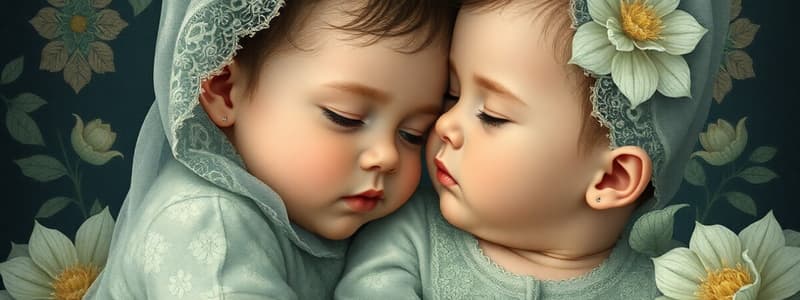Podcast
Questions and Answers
What is the primary function of emotions in infants as proposed by John Bowlby?
What is the primary function of emotions in infants as proposed by John Bowlby?
- To express physical comfort or discomfort
- To communicate the individual's current motivational state (correct)
- To signal when to sleep or eat
- To facilitate social interactions among peers
At what age does anger typically begin to develop in infants?
At what age does anger typically begin to develop in infants?
- 2-3 months
- 9-12 months
- 4-6 months (correct)
- 7-8 months
Which of the following emotions is associated with the Behavioral Inhibition System (BIS)?
Which of the following emotions is associated with the Behavioral Inhibition System (BIS)?
- Surprise
- Sadness (correct)
- Anger
- Joy
What is the primary impact of facial expressions of emotions in infants?
What is the primary impact of facial expressions of emotions in infants?
Which of the following is NOT considered a primary emotion in infants?
Which of the following is NOT considered a primary emotion in infants?
How do infants typically respond when frustrated according to their temperament?
How do infants typically respond when frustrated according to their temperament?
What developmental stage corresponds with the onset of anger in infants, according to Piaget?
What developmental stage corresponds with the onset of anger in infants, according to Piaget?
Which emotion is considered to be associated with the Behavioral Activation System (BAS)?
Which emotion is considered to be associated with the Behavioral Activation System (BAS)?
What is the primary focus of the film 'Grief: A Peril in Infancy'?
What is the primary focus of the film 'Grief: A Peril in Infancy'?
According to Spitz and Wolf's observations, how do infants respond to a mother's return after being absent for less than three months?
According to Spitz and Wolf's observations, how do infants respond to a mother's return after being absent for less than three months?
What happens to infants when their mothers are absent for an extended period beyond three months?
What happens to infants when their mothers are absent for an extended period beyond three months?
Which theory did Sigmund Freud propose regarding an infant's attachment to their mother?
Which theory did Sigmund Freud propose regarding an infant's attachment to their mother?
What critical observation did ethologists like Konrad Lorenz make about baby geese and their mothers?
What critical observation did ethologists like Konrad Lorenz make about baby geese and their mothers?
What role does the emotional climate created by the mother play in an infant's development, according to the film?
What role does the emotional climate created by the mother play in an infant's development, according to the film?
What implication does Spitz and Wolf's research have regarding the understanding of infant needs?
What implication does Spitz and Wolf's research have regarding the understanding of infant needs?
How did the views on infant attachment shift after Spitz and Wolf’s research compared to Freud’s earlier beliefs?
How did the views on infant attachment shift after Spitz and Wolf’s research compared to Freud’s earlier beliefs?
What factor is highlighted as influencing children's social development according to the Longitudinal Israeli Study of Twins?
What factor is highlighted as influencing children's social development according to the Longitudinal Israeli Study of Twins?
What is identified as a predictor of child structural brain development based on parental sensitivity?
What is identified as a predictor of child structural brain development based on parental sensitivity?
Which aspect of children's emotional development is emphasized during infancy?
Which aspect of children's emotional development is emphasized during infancy?
Who are the authors of the study that discusses the co-development of self and sociomoral emotions during toddler years?
Who are the authors of the study that discusses the co-development of self and sociomoral emotions during toddler years?
What key aspect does the cognitive theory of early gender development address?
What key aspect does the cognitive theory of early gender development address?
What type of vocalizations are examined in the context of social interaction in infants?
What type of vocalizations are examined in the context of social interaction in infants?
What does the research by Kopp and Neufeld focus on regarding emotional development during infancy?
What does the research by Kopp and Neufeld focus on regarding emotional development during infancy?
Which of the following statements is true regarding the assessment of children's social capabilities?
Which of the following statements is true regarding the assessment of children's social capabilities?
What does agency primarily encompass?
What does agency primarily encompass?
At what age do children typically begin to recognize themselves in mirrors and pictures?
At what age do children typically begin to recognize themselves in mirrors and pictures?
Which Erikson stage is associated with toddlers showing agency?
Which Erikson stage is associated with toddlers showing agency?
What aspect of temperament is connected to agency in toddlers?
What aspect of temperament is connected to agency in toddlers?
Which behavior is NOT typically observed in children under 12 months?
Which behavior is NOT typically observed in children under 12 months?
By what developmental stage do most toddlers begin expressing a desire for independence in their actions?
By what developmental stage do most toddlers begin expressing a desire for independence in their actions?
What emerges from experiences with agency, according to the content?
What emerges from experiences with agency, according to the content?
What is the relationship between agency and individual differences in toddlers?
What is the relationship between agency and individual differences in toddlers?
What role do caregivers play when they welcome children back after exploration?
What role do caregivers play when they welcome children back after exploration?
According to Bowlby, which characteristics should caregivers embody?
According to Bowlby, which characteristics should caregivers embody?
What is the significance of the Circle of Security Program motto?
What is the significance of the Circle of Security Program motto?
What does Self-Determination Theory suggest regarding children’s needs?
What does Self-Determination Theory suggest regarding children’s needs?
What was the aim of Mary Ainsworth's 'The Strange Situation' protocol?
What was the aim of Mary Ainsworth's 'The Strange Situation' protocol?
How should parents manage a child’s need for autonomy?
How should parents manage a child’s need for autonomy?
What outcome is associated with children who have caregivers as a safe haven?
What outcome is associated with children who have caregivers as a safe haven?
How do parents who model self-regulation behave?
How do parents who model self-regulation behave?
At what age do infants typically begin to speak their first words?
At what age do infants typically begin to speak their first words?
Which of the following describes 'infant-directed speech'?
Which of the following describes 'infant-directed speech'?
What is the main benefit of infant-directed speech in language acquisition?
What is the main benefit of infant-directed speech in language acquisition?
What typical behavior indicates that infants are beginning to acquire language around 4 to 6 months?
What typical behavior indicates that infants are beginning to acquire language around 4 to 6 months?
Which of the following statements about sex differences in language acquisition is true?
Which of the following statements about sex differences in language acquisition is true?
What does the concept of a 'sensitive period' refer to in early language development?
What does the concept of a 'sensitive period' refer to in early language development?
Which physical change in the brain supports language development during the infant-toddler period?
Which physical change in the brain supports language development during the infant-toddler period?
What finding was observed regarding infants' attention to speech?
What finding was observed regarding infants' attention to speech?
Flashcards
What triggers anger in infants?
What triggers anger in infants?
The infant’s intentional action is blocked, usually by another person, leading to frustration and anger.
Why are emotions important for infants?
Why are emotions important for infants?
Infants' emotions are an essential communication tool, revealing their needs and motivations.
How do infants learn about emotions?
How do infants learn about emotions?
Infants learn to express emotions by observing how others respond to their needs.
What is the BIS?
What is the BIS?
Signup and view all the flashcards
What is the BAS?
What is the BAS?
Signup and view all the flashcards
What are primary emotions?
What are primary emotions?
Signup and view all the flashcards
Which emotions are linked to the BIS?
Which emotions are linked to the BIS?
Signup and view all the flashcards
Which emotions are linked to the BAS?
Which emotions are linked to the BAS?
Signup and view all the flashcards
Grief: A Peril in Infancy
Grief: A Peril in Infancy
Signup and view all the flashcards
Freud's Theory on Infant Love
Freud's Theory on Infant Love
Signup and view all the flashcards
Imprinting in Baby Geese
Imprinting in Baby Geese
Signup and view all the flashcards
Beyond Food: Understanding Emotional Bonds
Beyond Food: Understanding Emotional Bonds
Signup and view all the flashcards
Emotional Distress in Infants
Emotional Distress in Infants
Signup and view all the flashcards
Recovery from Separation
Recovery from Separation
Signup and view all the flashcards
Long-Term Separation Effects
Long-Term Separation Effects
Signup and view all the flashcards
Mother's Role in Child Development
Mother's Role in Child Development
Signup and view all the flashcards
What is a 'safe haven'?
What is a 'safe haven'?
Signup and view all the flashcards
What is a 'secure base'?
What is a 'secure base'?
Signup and view all the flashcards
What is the Circle of Security motto?
What is the Circle of Security motto?
Signup and view all the flashcards
What is the 'Strange Situation' protocol?
What is the 'Strange Situation' protocol?
Signup and view all the flashcards
How do individual differences affect attachment?
How do individual differences affect attachment?
Signup and view all the flashcards
What are attachment styles?
What are attachment styles?
Signup and view all the flashcards
Is attachment instinctive?
Is attachment instinctive?
Signup and view all the flashcards
Why is attachment theory important?
Why is attachment theory important?
Signup and view all the flashcards
Infant Speech Comprehension
Infant Speech Comprehension
Signup and view all the flashcards
Infant-Directed Speech
Infant-Directed Speech
Signup and view all the flashcards
Sensitive Period
Sensitive Period
Signup and view all the flashcards
Programmed Cell Death
Programmed Cell Death
Signup and view all the flashcards
Infant Tone Sensitivity
Infant Tone Sensitivity
Signup and view all the flashcards
First Word Development
First Word Development
Signup and view all the flashcards
Toddler Language Skills
Toddler Language Skills
Signup and view all the flashcards
Sex Differences in Language
Sex Differences in Language
Signup and view all the flashcards
What is agency?
What is agency?
Signup and view all the flashcards
What is self-concept?
What is self-concept?
Signup and view all the flashcards
What is autonomy?
What is autonomy?
Signup and view all the flashcards
Erikson's stage of Autonomy vs. Shame and Doubt
Erikson's stage of Autonomy vs. Shame and Doubt
Signup and view all the flashcards
What is dominance behavior in toddlers?
What is dominance behavior in toddlers?
Signup and view all the flashcards
What is reward responsiveness?
What is reward responsiveness?
Signup and view all the flashcards
When do infants develop a sense of self?
When do infants develop a sense of self?
Signup and view all the flashcards
How do infants express a sense of self?
How do infants express a sense of self?
Signup and view all the flashcards
Emotional Development
Emotional Development
Signup and view all the flashcards
Nature and Nurture in Emotional Development
Nature and Nurture in Emotional Development
Signup and view all the flashcards
The Strange Situation
The Strange Situation
Signup and view all the flashcards
Attachment Theory
Attachment Theory
Signup and view all the flashcards
Safe Haven
Safe Haven
Signup and view all the flashcards
Secure Base
Secure Base
Signup and view all the flashcards
Attachment Styles
Attachment Styles
Signup and view all the flashcards
Genetics and Social Development
Genetics and Social Development
Signup and view all the flashcards
Study Notes
Chapter 5: Infant/Toddler Psychosocial Development
- Learning Objectives: Explain emotional development in infants and toddlers, describe temperament and biological markers of temperament, describe infant social behavior, explain the significance of the still-face paradigm, explain intergenerational transmission of caring, explain the dominance system, describe self-development, explain self-regulation and its development, describe early language development, and discuss assessment of infants and toddlers.
Emotional Development in Infants and Toddlers
- Emotional Responses: Infants exhibit attraction to pleasant situations and withdrawal from unpleasant stimuli. Attraction activates the Behavioral Approach System (BAS) while withdrawal activates the Behavioral Inhibition System (BIS). These brain circuits controlling approach and withdrawal are not fully formed at birth, leading to limited emotional responses.
- Primary Emotions and Age: Infants' primary emotions (e.g., interest, curiosity, surprise, joy, pain, sadness, disgust, anger, fear) emerge at different ages reflected in facial expressions. Table 5-1 outlines the progression.
Temperament
- Differentials: Differences in temperament between children are visible from birth. Three approaches measure these individual differences in infancy.
The Mother-Infant System
- Communication: Caregivers experience their infants differently, and this dynamic influences the mother-infant interaction, impacting the communication pattern. Goodness of fit is key, where matching styles allow smooth interaction.
- Infant Styles: Easy (40%), slow-to-warm-up (15%), and difficult (10%) are defined based on infant behaviors impacting caregiving and system functionality. Difficult infants need additional support.
- Influence: Parents are affected by their children as much as the other way round. Temperament differences also impact parent-child relationship dynamics and parental satisfaction.
The Biopsychology of Temperament
- Biological Markers: Temperament has biological markers, including frontal EEG asymmetry (right frontal cortex activity relates to the Behavioral Inhibition System (BIS), while left frontal cortex activity relates to the Behavioral Approach System (BAS)), and skin conductance (sympathetic nervous system activation in response to fear or stress).
- Heart Rate: Another biological marker is heart rate variability (RSA), which relates to parasympathetic activity.
Infant Social Behavior
- Trust vs. Mistrust (Erikson): Infants develop trust when caregivers respond to their needs. Conversely, mistrust develops when care is inconsistent leading to future issues in social interaction.
- Attachment: Infants develop attachment bonds by 9 months, showing a preference for their caregivers.
Child's Play and Direct Evidence for Internal Working Models of Caregiving
- Imitative Behaviors: Infants imitate the behaviors of others, forming internal working models about giving and receiving care. These models influence play and interaction, and these preverbal memories can be used to learn about giving care.
Empathy in Infants and Toddlers
- Development: Empathy emerges over 8-16 months, reflected in an attempt to assist or help distressed individuals.
- Cognitive Aspects: Empathy relates to perspective taking and emotional contagion, with empathy for familiar figures preceding empathy in unfamiliar individuals.
The Dominance System
- Agency: Infants' understanding of agency—a feeling of control over their actions and consequences—develops by 6 months. Infants' sense of self and self-concepts develop around this age and involve understanding the agency of others and self-interest.
The Sexual System
- Biological Development: Children's understanding of gender develops from birth onward with the recognition of male and female categories typically around 6 to 12 months. Schemas around gender influence other social interactions.
Infant and Toddler Cognition, Serve and Return, Self-Regulation, and Early Language
- Cognition: Development focuses on sensory-motor experiences and the development of visual systems and attention in the first 3 months. Memory and imitation evolve during this period. Object permanence occurs around 9 months.
- Serve and Return: Effective caregiver responses to infant cues are critical for brain development, communication, and social skills. The relationship between responsiveness and child development is important from birth onward.
- Self-Regulation: Infants’ ability to self-soothe or regulate emotions is absent or limited in infancy but starts developing by 3 months. External help is sought by a child to improve self-regulation.
- Language Development: From birth to 2 years, infants progress from reflexive behavior to intentional actions in their attempt to communicate, exhibiting imitation, comprehension, and language production stages. Table 5-4 illustrates language milestones.
- Infant-directed speech: Infants respond more to this type of speech which is used in all cultures. Infant directed speech is tuned to child's interests, in addition to clarity and enthusiasm.
Autism Spectrum Disorders (ASDs) in Toddlers
- Characteristics: ASDs manifest around a child's first birthday, and include difficulties in social communication, play behavior, language, sensory differences, and motor development, as well as attention and eating.
Early Language Milestone Scale (ELM)
- Assessment: This assessment measures developmental milestones around speech and language from birth to 3 years.
Neonatal Behavioral Assessment Scale (NBAS)
- Assessment: This assessment examines the behavior and neurological status of infants up to 2 months.
Studying That Suits You
Use AI to generate personalized quizzes and flashcards to suit your learning preferences.




